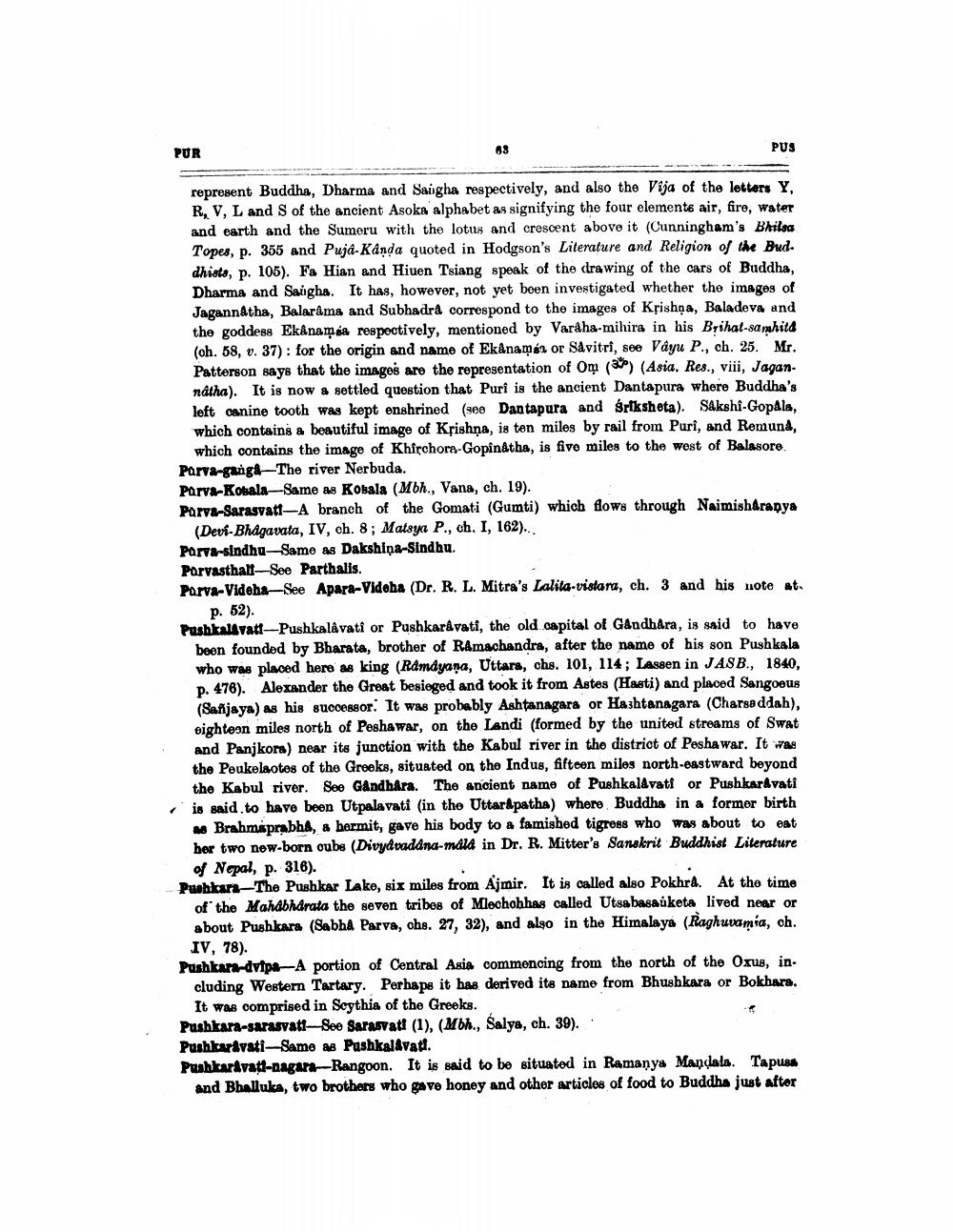________________
PUR
63
PUS
represent Buddha, Dharma and Saigha respectively, and also the Vija of the letters Y, R, V, L and S of the ancient Asoka alphabet as signifying the four elements air, fire, water and earth and the Sumeru with the lotus and crescent above it (Cunningham's Bhilsa Topes, p. 355 and Puja-Kanda quoted in Hodgson's Literature and Religion of the Bud dhists, p. 105). Fa Hian and Hiuen Tsiang speak of the drawing of the cars of Buddha, Dharma and Saugha. It has, however, not yet been investigated whether the images of Jagannatha, Balarama and Subhadra correspond to the images of Krishna, Baladeva and the goddess Ekânama respectively, mentioned by Varaha-mihira in his Brihat-samhita (oh. 58, v. 37): for the origin and name of Ekânamén or Savitri, see Vayu P., ch. 25. Mr. Patterson says that the images are the representation of Om (3) (Asia. Res., viii, Jagan. natha). It is now a settled question that Purî is the ancient Dantapura where Buddha's left canine tooth was kept enshrined (see Dantapura and śrfksheta). Sakshi-Gopala, which contains a beautiful image of Krishna, is ten miles by rail from Puri, and Remuna, which contains the image of Khirchora-Gopinatha, is five miles to the west of Balasore Parva-ganga-The river Nerbuda.
Parva-sindhu Same as Dakshina-Sindhu.
Parvasthall-See Parthalis.
Parva-Kobala-Same as Kosala (Mbh., Vana, ch. 19).
Parva-Sarasvati-A branch of the Gomati (Gumti) which flows through Naimisharanya (Devi-Bhagavata, IV, ch. 8; Matsya P., ch. I, 162)...
Parva-Videha-See Apara-Videha (Dr. R. L. Mitra's Lalita vistara, ch. 3 and his note at p. 52).
Pushkalavati-Pushkalavati or Pushkaravati, the old capital of Gandhara, is said to have been founded by Bharata, brother of Ramachandra, after the name of his son Pushkala who was placed here as king (Ramayana, Uttara, chs. 101, 114; Lassen in JASB., 1840, p. 476). Alexander the Great besieged and took it from Astes (Hasti) and placed Sangoeus (Sanjaya) as his successor. It was probably Ashtanagara or Hashtanagara (Charsaddah), eighteen miles north of Peshawar, on the Landi (formed by the united streams of Swat and Panjkora) near its junction with the Kabul river in the district of Peshawar. It was the Peukelaotes of the Greeks, situated on the Indus, fifteen miles north-eastward beyond the Kabul river. See Gândhåra. The ancient name of Pushkalavati or Pushkar&vati is said to have been Utpalavati (in the Uttarapatha) where Buddha in a former birth as Brahmaprabha, a hermit, gave his body to a famished tigress who was about to eat her two new-born cubs (Divyavadana-mála in Dr. R. Mitter's Sanskrit Buddhist Literature of Nepal, p. 316).
Pushkara-The Pushkar Lake, six miles from Ajmir. It is called also Pokhra. At the time of the Mahabharata the seven tribes of Mlechohhas called Utsabasaŭketa lived near or about Pushkara (Sabha Parva, chs. 27, 32), and also in the Himalaya (Raghuvamia, ch. IV, 78).
Pushkara-dvipa-A portion of Central Asia commencing from the north of the Oxus, including Western Tartary. Perhaps it has derived its name from Bhushkara or Bokhara. It was comprised in Scythia of the Greeks. Pushkara-sarasvati-See Sarasvati (1), (Mbh., Śalya, ch. 39).
Pushkaravati-Same as Pushkalavati. Pushkaravati-nagara-Rangoon. It is said to be situated in Ramanya Mandala. Tapusa and Bhalluka, two brothers who gave honey and other articles of food to Buddha just after




